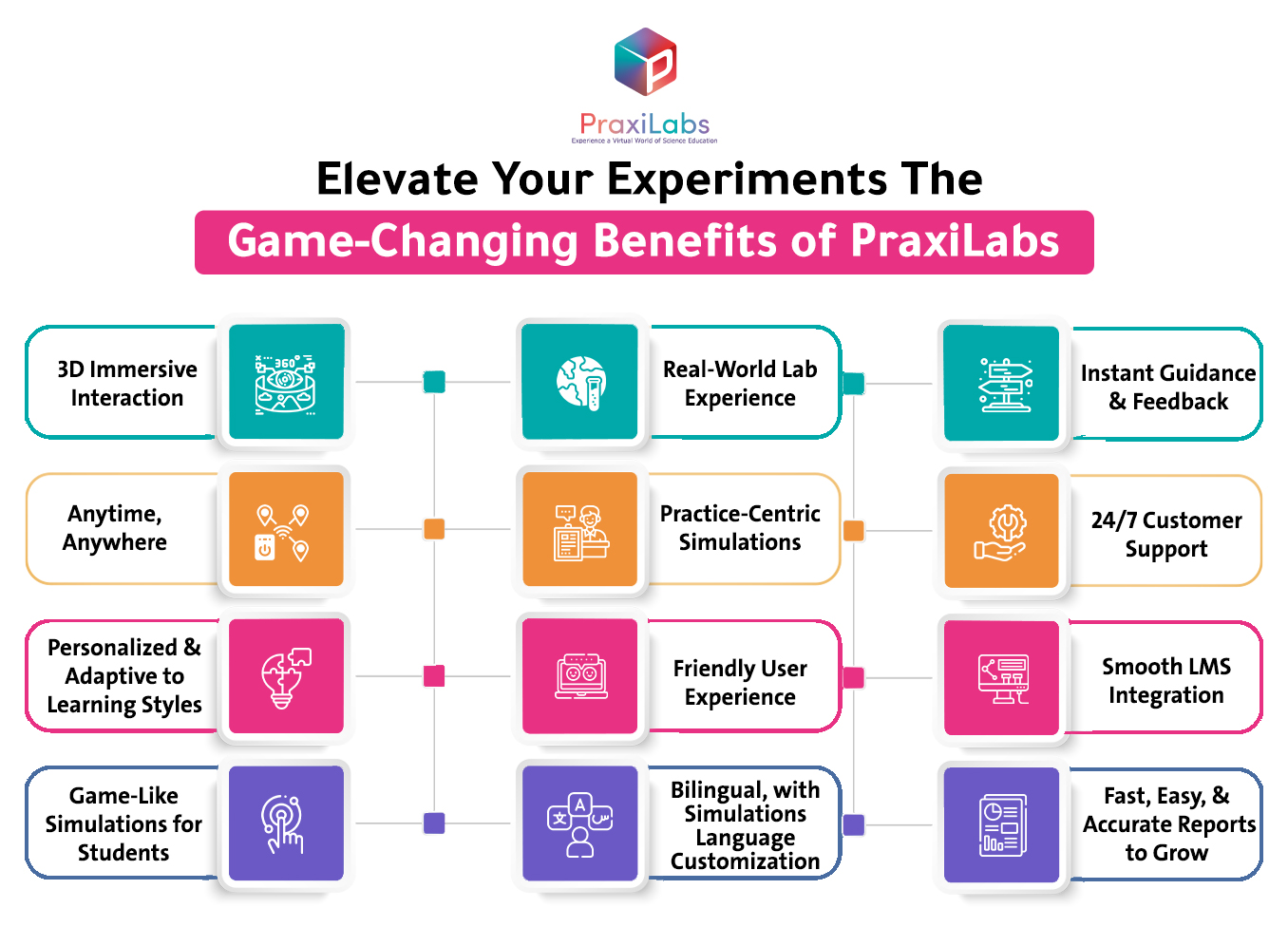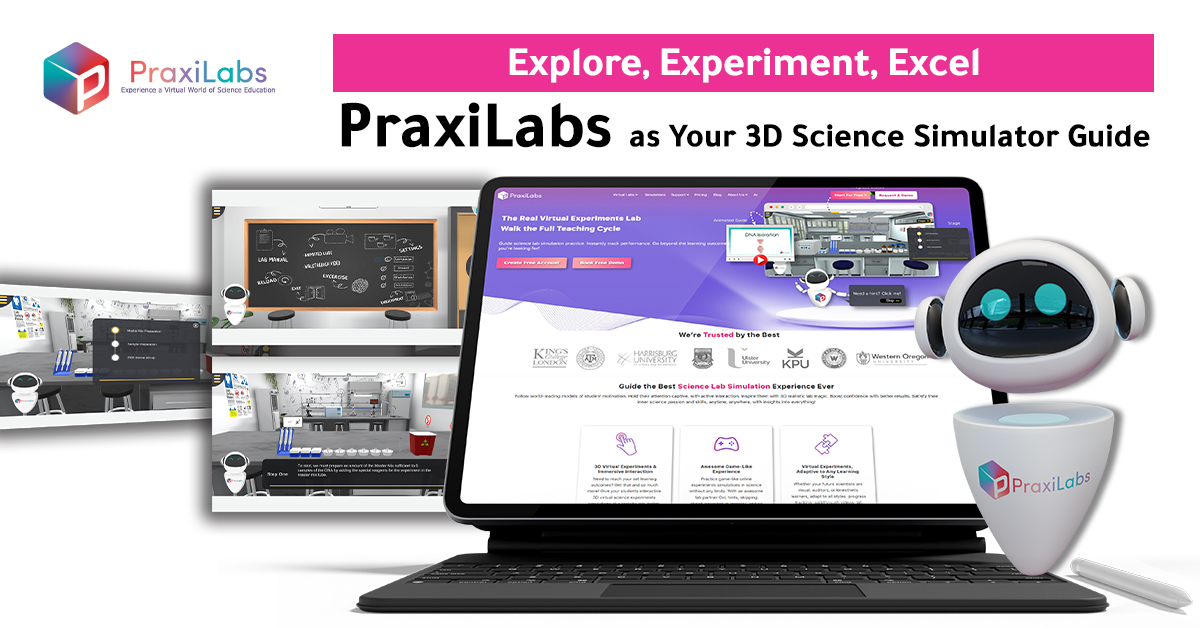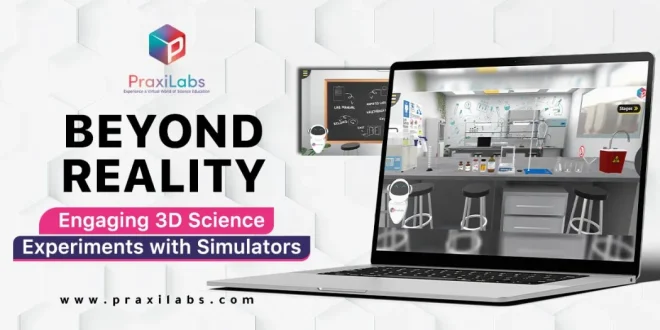Last Updated on August 22, 2025 by Muhamed Elmesery
Learning about science through listening to lectures and reading about it, though valuable, isn’t always enough to truly engage students. Learning by doing science, through hands-on science activities and experiments lets students see what they’ve learned in action and develop a deeper understanding of the subject.
Hands-on learning using technological methods such as conducting 3D science experiments with simulators is a great way to refer to learning by doing and enriching the experimentation process by providing visual aids that guide the students through the process.
In this blog, we will dive into the world of 3D science experiments using simulators, their concept, benefits, examples, the role of 3D experiment models in modern sciences, how to get started with them, and effective tips for educators on integrating simulators into their curriculum.

Table of Contents
The Concept of 3D Science Simulators |Why 3D Simulators Are the New Lab Partners
The 3D science experiments using simulators are widely used in e-learning techniques. They refer to immersive and interactive 3D simulations of science experiments and activities that typically take place in physical laboratory settings. They simulate the tools, devices, and procedures which are used in various science branches such as chemistry, physics and biology, and this enables students to perform 3D science experiments online, from their personal devices anytime and anywhere without the costs and limitations of a physical lab.
The 3D science simulators use software and computer 3D experimental models to replicate the equipment, procedures, and experiments that would typically be done in a physical lab. Students can interact with the 3D science experiments by performing experiments and analyzing results, all within the simulated environment. The 3D science simulators aim to provide an immersive and interactive learning experience, offering benefits such as flexibility, accessibility, visual learning, cost-effectiveness, safety, and more.

Transform Your Learning: The Advantages of 3D Science Simulations
Conducting 3D science experiments using simulators provides a wide range of interactive features such as:
Immersive Interaction and Virtual 3D Science Experiments
3D science experiments using simulators provide immersive, interactive 3D virtual science experiments simulations (Experiment 3D models)of a realistic lab for educators with better management of time, skills and knowledge ,thereby increasing the learning outcomes.
Cost-Effectiveness
Conducting some experiments in real laboratories can be very expensive. Virtual simulators eliminate the need for expensive tools, equipment, materials, and maintenance required for doing experiments, so educational institutions can invest in virtual laboratories to provide their students with a greater number of experiments and also save more money.
Enhanced Safety
Doing experiments using a simulator protects students from any dangers they may face while conducting dangerous experiments in real labs. It is an effective method for preventing laboratory accidents by eliminating the handling of toxic substances or radioactive chemicals and other hazards such as electricity and pathogens. So, Virtual labs provide a safe environment for students and ensure their safety while exploring various scientific concepts and protocols.
Time Efficiency
By using virtual labs, students can save more time and effort, as they eliminate the need to move between different laboratories. Students can save time by accessing experiments, and learning resources without the need for setup or cleanup which enables them to focus more on the core learning objectives.
Available Anytime, Anywhere and for Many Times
3D science experiments using simulators provide a virtual learning and teaching environment that aims to develop the student’s practical skills and learning outcomes. Since they are available through the Internet, students can perform many different experiments without being restricted to specific places or specific times as is the case with real laboratories. Students can conduct their experiments with 24/7 unlimited access.
Also, by using the virtual labs students can repeat their virtual 3d science experiments many times, until they grasp and understand all the information.
On PraxiLabs, you can find various virtual lab simulations accessible anytime and anywhere.
Explore the Extraordinary: Exciting Examples of 3D Science Experiments
PraxiLabs, the 3D virtual lab solution, provides students with access to realistic biology, chemistry, and physics labs and enriches their understanding with a variety of informational and educational content.
Now let’s explore some examples of 3D science experiments in branches of Physics, chemistry, and Biology!
Physics Simulations
Archimedes Principle Virtual Lab
Learn how to determine the relative density or specific gravity (SG) of solids and liquids using Archimedes’ Principle.
By the end of the experiment, your students will be able to
- Understand Archimedes’ principles concept and the physics behind buoyant force.
- Set up an experiment to detect the specific gravity of a solid or a liquid. Hence, the material can be identified.
Chemistry Simulations
Determination of Chloride Concentration of Water Sample Virtual Lab
Learn how to determine the concentration of chlorides in water samples by Volhard’s method.
By the end of the experiment, your students will be able to
- Understand the concept and procedure of the Volhard Method.
- Analyze Chloride by following Volhard’s method.
Biology simulations
DNA Extraction Virtual Lab
Learn how to extract cellular DNA using the phenol/chloroform method.
By the end of the experiment, your students will be able to:
- Demonstrate proficiency with the procedures involved in DNA extraction.
- Identify the role of specific reagents and equipment in the DNA extraction process..
- Practice basic laboratory techniques.
- Understand and explain downstream applications of DNA extraction.


Explore, Experiment, Excel: PraxiLabs as Your 3D Science Simulator Guide
PraxiLabs is a leading e-learning company that provides interactive 3D science simulators that are safe, affordable and accessible anytime/anywhere for educational institutions and students in more than 20 science branches.
Overview of PraxiLabs’ science branches:
Biology virtual labs:
- Molecular Biology
- Genetics
- Microbiology
- Biochemistry
- Forensics
- Proteomics
- Toxicology
- Pharmacology
- Cell culture
- Microscopy
- Bioenergetics
- Immunology
Physics virtual labs:
- Heat and thermodynamics
- Properties of matter
- Electricity
- Magnetism
- Modern physics
- Mechanics
- Waves
Chemistry virtual labs:
- Analytical chemistry
- Organic chemistry
- Inorganic chemistry
To get started with 3D science simulators, you need to:
- Create a Free Account
- Choose from the Simulations
- Practice as Many Times as You Want
For more details, watch the following video that provides a step-by-step guide on using PraxiLabs virtual labs
Are you tired of seeing your students struggle to grasp complex scientific concepts? Request a Live Demo Now and Increase your Students’ Learning Retention and Engagement With PraxiLabs’ virtual labs!

Level Up Your Teaching: Tips for Integrating Simulators into the Classroom
Integrating simulators into the educational curricula can significantly improve learning experiences by providing students with practical, hands-on opportunities to apply theoretical knowledge.
Even more information and useful data will be provided to help students better understand the experiments that are being studied through clear guides on which tools, materials, and devices to use for different experiments and ,how to use them, and most importantly, why.
Here are some effective tips for educators looking to integrate simulations into their educational curriculum:
- Define and establish clear learning outcomes ,which helps in choosing the suitable simulations that are aligned with educational goals.
- Select the appropriate simulations that reflect the context of the curriculum. For instance, Science educators might use virtual lab simulations to teach their students various science experiments.
- Foster deep learning for your students as this approach improves critical thinking and problem-solving skills, as students must navigate complex scenarios that mimic real-world challenges.
- Provide support and guidance to your students before engaging with simulations to understand the objectives and the mechanics of the simulation. This preparation can increase students’ confidence and engagement.
- Facilitate reflection and debriefing sessions after completing a simulation, where students can reflect on their experiences, analyze what they learned, and more. Reflection is a key component of experiential learning.
- Incorporate technology wisely to enhance the learning experience.
- Evaluate the effectiveness of the simulations. This can be done through assessments, feedback from students, and analysis of learning outcomes.
With PraxiLabs One day “plug & play” setup, and integration we have you up and running right away, reviewing your students’ performance in real time, setting up courses and aligning with your students.
 PraxiLabs A virtual world of science
PraxiLabs A virtual world of science






